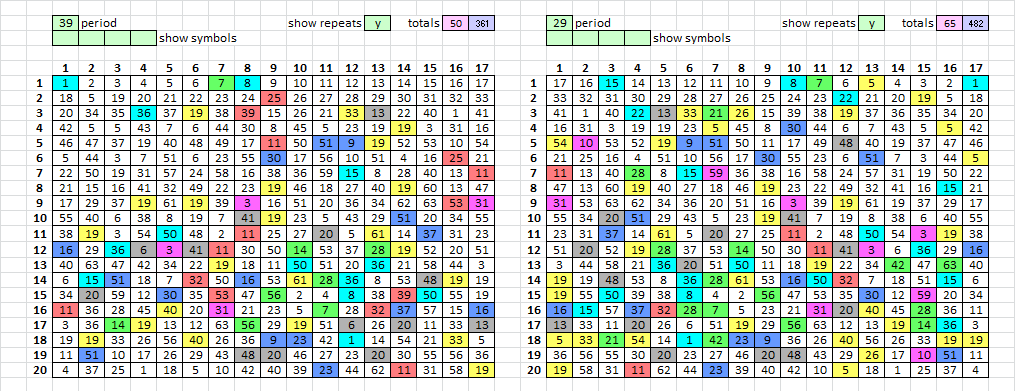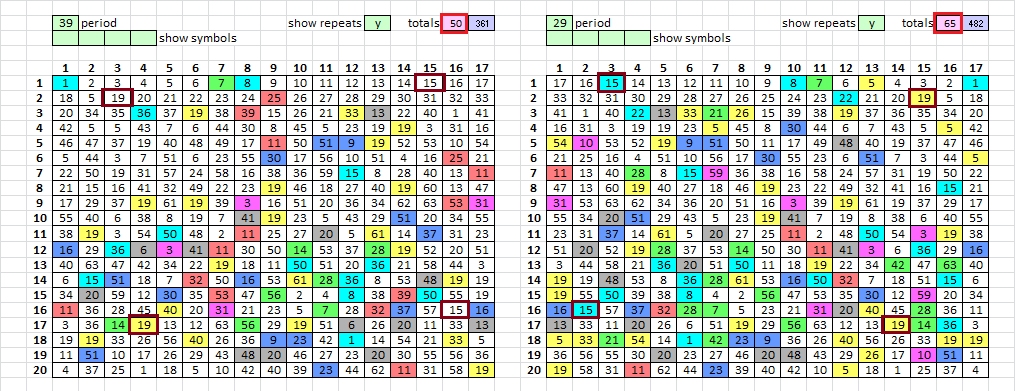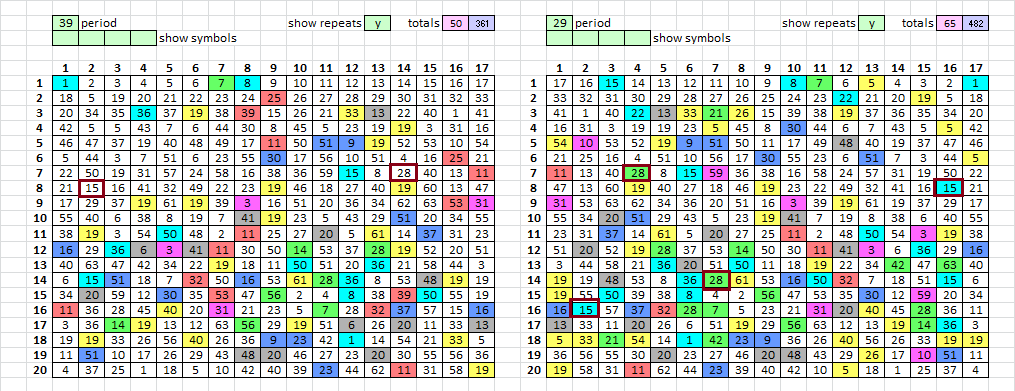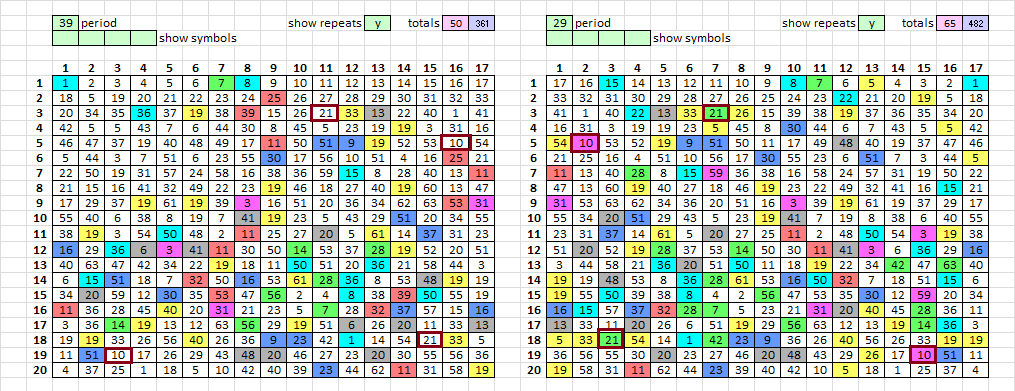Back to the period 29 – period 39 mystery, where if the message is mirrored, there are a lot more period 29 matches than there are period 39 matches. Which seems unusual because you would think that the numbers would be closely the same. But the cause of that is either the mirroring process, or that Zodiac transcribed from right to left instead of left to right. I will show that the mirroring process can distort the bigram repeat stats.
Here is the configuration that makes people think that a period 39 reversed is always going to be a period 29. And in a lot of cases it is. Above, AB are period 39. Below, AB are period 29 because the message was mirrored.
On the left are the period 39 matches with 50 count, and on the right are the period 29 mirrored matches with 65 count. Big difference and 65 is a high number.
Here is an example of a period 29 match that is created by the mirroring process. See the dark brown boxes. Symbols 15 and 19 are period 5 matches in the original message on the left, and when mirrored, become new period 29 matches. In short, there are other periods besides period 39 that become period 29 when the message is mirrored.
Here is another example. With the original message on the left, symbols 28 and 15 are period 5. When mirrored on the right, they become period 29 and match with a period 29 below.
Here is another example. With the original message on the left, symbols 21 and 10 are period 39 and period 5 respectively. When the message is mirrored, they both become period 29 and match with each other.
So, mirroring a message can be deceptive. Sure, he could have transcribed left to right, but there is still no explanation for how there could be such a high count of both period 15 and period 29 matches. It is possible that the high count of period 29 matches in the mirrored message are merely created by the mirroring process.
Smokie, thanks for posting the references to the earlier discussion, and the details of your periodic bigram analysis. The examples showing the mirroring relation between periods 5, 29 and 39 are very useful. I think it may be good to produce formulas, or some kind of reference, that relate the various periods to each other with regard to mirroring. A bonus would be to produce a formula that even includes the grid dimensions. Then we could punch in the inputs (periods, grid length and width), and then see what the related periods would be under mirroring.
I’m sorry you are feeling burned out and I hope you find some relief.
I will try to dive in deeper with the reproduction of the bigram peaks phenomena for transposed cipher texts when I’ve exhausted the generation of Z340-like non-transposed substitution ciphers. It is challenging to simulate all the odd qualities of the Z340. I have about a dozen different measurements that the cipher generator uses in its multiobjective optimization search. But with so many objectives explored during the search, it is easy to lose out on a particular measurement while gaining on another. This is the "curse of high dimensionality". The other factor at play is that since Z340 is very likely NOT a "normal" simple substitution cipher, forcing the simple substitution ciphers to resemble Z340 is more difficult than doing so for the correct scheme, whatever it may be. When I switch to generating transposition ciphers, it will be interesting to see if all the different simple variations of them can be solved in general using azdecrypt or similar tool. If so, we can have more confidence when excluding very specific schemes and variations. If not, we need stronger decryption tools – otherwise, we might have already guessed a correct hypothesis but lacked a generalized tool to unlock the plaintext for us. It’s very time consuming because we need to be sure that even the most basic transposition type (say, columnar transposition without variations such as gaps and misalignments) can be efficiently solved using available tools.
I am hoping that you will discover a way to avoid all this work by uncovering the correct scheme by your experiments!
Your point about route transpositions having a greater chance of producing periodic pivots is very interesting. That seems to be a path very much worth exploring. It’s strange to me though that the pivots are still intact even after the inscription and transcription are applied (especially the horizontal portions of the pivots).
Your point about route transpositions having a greater chance of producing periodic pivots is very interesting. That seems to be a path very much worth exploring. It’s strange to me though that the pivots are still intact even after the inscription and transcription are applied (especially the horizontal portions of the pivots).
I am still working on the 340 a little bit at a time. What about viewing the pivots as not pivots, but three sets of period 39 repeats with the same symbols. That could easily be created when the same word or words are used a few times. And they just happen to line up with each other. On the other hand, I was thinking last night that they could be an intentional clue. Maybe Zodiac put the pivots there to give a clue that the message is a transposition cipher. The directions point in perpendicular directions, which is what a rectangular transposition is. And he did it twice to make sure that we didn’t miss it. I also thought that maybe they form the corners of rectangle shapes that he transcribed the message into. I guess we just have to keep trying. I am going to explore how AZD progressive scores vary depending on different factors.
What about viewing the pivots as not pivots, but three sets of period 39 repeats with the same symbols. That could easily be created when the same word or words are used a few times. And they just happen to line up with each other
That makes sense. It would be interesting to revisit the pivot analysis with that in mind. What is the probability that a plaintext message, when inscribed and transposed, would create these periodic repeating bigrams that just happen to line up this way?
One way I can see to test that is to repeat the scan of the huge Gutenberg corpus, casting 340-character chunks into the 17×20 grid, applying the transposition, then looking for pivots. Then we can compare the rate of appearance to that of the untransposed test.
Maybe Zodiac put the pivots there to give a clue that the message is a transposition cipher. The directions point in perpendicular directions, which is what a rectangular transposition is. And he did it twice to make sure that we didn’t miss it. I also thought that maybe they form the corners of rectangle shapes that he transcribed the message into.
Yes, and maybe the box corners that intersect with the repeating 3-symbol fragment have some connection:

I wonder if it’s significant that each one of the "box corners" appears exactly 1 column to the right of a pivot pattern.
Here is another observation of unknown significance:

Repeating bigrams of period 1 are highlighted. Notice how they seem to have a phobia of the lower left region of the cipher text. This region seems to be bounded by the pivot patterns.
Compare that to how well-distributed the bigrams are in the 408:

Maybe different schemes are being applied to different regions of the cipher text. Also, could that "bigram-phobic" region also be responsible for interruptions in the homophone cycles?
I also wondered about considering two periods at once when counting bigram repeats. For example, count the bigrams when period p1 is applied, and count the bigrams when period p2 is applied. Merge the results (example: AB occurs 2 times at period p1 and 4 times at period p2, so when merged the AB count is 6). What is the combination of periods that produces the max number of repeats? Perhaps such a combination reflects two different transposition schemes going on in the cipher text.
As you can see it’s hard to stay focused on one thing. ![]()
hi doranchak ..can you put the period 19s up in the above format and include the known pivots (in black).
Note that most of the period 39 repeats occur in the bottom half of the message, and there is a big area on the upper left, bounded by the leftmost pivot, where there are few.
That makes sense. It would be interesting to revisit the pivot analysis with that in mind. What is the probability that a plaintext message, when inscribed and transposed, would create these periodic repeating bigrams that just happen to line up this way? One way I can see to test that is to repeat the scan of the huge Gutenberg corpus, casting 340-character chunks into the 17×20 grid, applying the transposition, then looking for pivots. Then we can compare the rate of appearance to that of the untransposed test.
I suggest a simple 17 x 20 inscription rectangle, and look for pivot pairs that face the same direction, whether EDIT: northwest or southeast, at periods 20, 40 and maybe 60. Just as a test.
I haven’t put much thought into the box corners.
Maybe different schemes are being applied to different regions of the cipher text. Also, could that "bigram-phobic" region also be responsible for interruptions in the homophone cycles?
I agree.
I also wondered about considering two periods at once when counting bigram repeats. For example, count the bigrams when period p1 is applied, and count the bigrams when period p2 is applied. Merge the results (example: AB occurs 2 times at period p1 and 4 times at period p2, so when merged the AB count is 6). What is the combination of periods that produces the max number of repeats? Perhaps such a combination reflects two different transposition schemes going on in the cipher text.
I have done similar research into what I call cross-period analysis, with a big 40 x 40 table ( 1600 possible two period combinations ) that looks like this:
The above is the mirrored version of the 340, and I did not yet finish the regular version. The idea was to see if I could detect an irregular inscription rectangle. I made a test message and I couldn’t. Results are widely varied and difficult to interpret or compare.
With the regular 340, try periods 11 and 24. I believe they should give very high results as compared to any other two period comparison ( periods 1 – 40 ).
Honestly though I think that my cross period experiments taught me very little, and that’s when I focused on multi inscription rectangles.
hi doranchak ..can you put the period 19s up in the above format and include the known pivots (in black).
Sure! I will do that as soon as I get a chance.
I suggest a simple 17 x 20 inscription rectangle, and look for pivot pairs that face the same direction, whether northwest, northeast, southeast, or southwest, at periods 20, 40 and maybe 60. Just as a test.
I’ve added it to my to-do pile. ![]()
I have done similar research into what I call cross-period analysis, with a big 40 x 40 table ( 1600 possible two period combinations ) that looks like this:
Ah! Very nice. I am not sure how to interpret it either. Will have to ponder on it later.
I was curious about how periods in the normal scheme are equivalent to periods in the mirrored scheme. So here’s a preliminary version of my new "period calculator" gadget:
http://zodiackillerciphers.com/period-calculator/
First, you enter the cipher dimensions and the period you are interested in.

You’ll then see the original layout. Positions are numbered sequentially. If your cipher dimensions work out to length 340, the "pivots" will be highlighted.

Next, it un-transposes the original layout with your period.
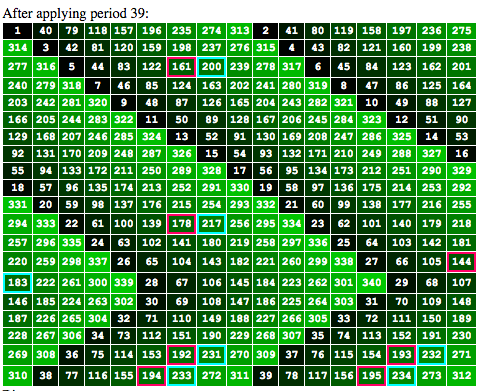
So it shows you where the original positions have relocated after un-transposing. Below it gives you the number of bigrams that have formed at the selected period. In this example, the count is only 301, because the other 38 bigrams overlap the bottom of the original layout.

Then your original layout is mirrored horizontally and un-transposed using your period.
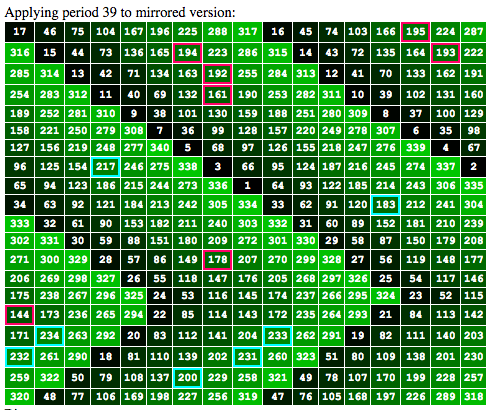
Below it gives you the bigram totals at equivalent periods from the original (unmirrored) layout.

In this example, we un-transposed the mirrored layout with period 39. 216 of the resulting bigrams are equivalent to bigrams that are produced when un-transposing the original (unmirrored) layout with period 29. 85 of the resulting bigrams are equivalent to bigrams that are produced when un-transposing the original (unmirrored) layout with period 63.
Here’s an interesting observation (maybe): For Z340, if you un-transpose the original layout with period 19, you get the highest number of repeating bigrams. And the pivots unfold into these rather orderly-looking diagonals:
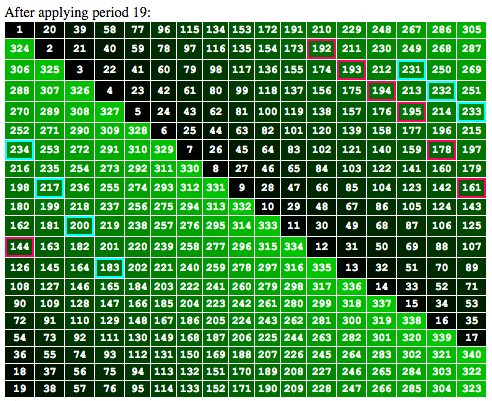
Don’t know if it means anything, but it looked interesting to me.
Anyway, take a look, and let me know if you find any problems. I also want to know what you guys might want to see in this calculator tool. I was thinking about adding some kind of overlay to show the real symbols from Z340 in the boxes.
Next, it un-transposes the original layout with your period.
So it shows you where the original positions have relocated after un-transposing. Below it gives you the number of bigrams that have formed at the selected period. In this example, the count is only 301, because the other 38 bigrams overlap the bottom of the original layout..
So these are the positions of the pivot symbols before transposition… right?
Here’s an interesting observation (maybe): For Z340, if you un-transpose the original layout with period 19, you get the highest number of repeating bigrams. And the pivots unfold into these rather orderly-looking diagonals:
Don’t know if it means anything, but it looked interesting to me.
Yes, that is very interesting. I will think about it.
So these are the positions of the pivot symbols before transposition… right?
Yes. The numbers always refer to the position in the original layout (before transposition).
Good work doranchak. The visuals really help. The formats you are using are easy to follow? I find that really interesting the period 39’s bringing the two pivots together. Not sure what to make of it yet. I will do a skytale on the 39s and highlight the pivots before I start just to see what happens. When I get some time.
Cheers
Edited..

